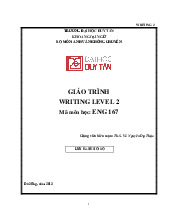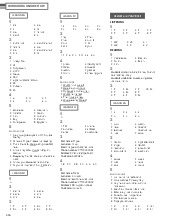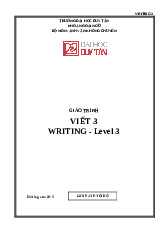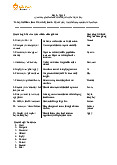











Preview text:
Week 21: 29/1-15/2/2024
Date of planning: 27/1/2023 Date of teaching: 29/1-15/2/2024 Period: 61 TEST YOURSELF D A/ Objective:
1/ Aims:students review the knowledge in unit 9,10 2/ Knowledge: general
3/ Skil : listening,reading,writing
B/ Method: communicative approarch.
C/ Teaching aids: text book, tapescrpt D/ procedure: Time Teacher’s activities Students’ activities I/ Listening: Individual Give answer T give ss to listen two times -T gives feedback 1. Bamboo shoots leaves 2. 12 Pairwork 3. 600 4. half 5. cloning Read and answer II/ Reading:
-T asks ss to read the passage and an the questions -T gives feedback 1F 2NM 3T 4T 5T Listen and give thei
III/ Pronunciation and grammar answer 1/ Listening: -T gives the feedback 2/ Grammer:
-T asks ss to do the exercise and exp Do exercise them -T gives feedback 1 needn’t/ must/ mustn’t 2. mustn’t 3.needn’t/ must groupwork 4. mustn’t 5. mustn’t 6.mustn’t 7.needn’t IV/ Writing:
Write a passage abuot the change in lives in the next 30 years
-T gets ss to answer the questions
-T asks ss to write on your poster and t them on the board -T corrects the mistakes Unit 11: BOOKS Period:62 READING
I. Aims: By the end of the lesson, students can: + Develop their reading skil
+ Understand how to read books II. Method and teaching aids: + Integrated
+ Books, pictures, posters, charts III. Procedures: Stages Teacher’s Activities Students’ Activities Warmer Guessing game (4’) * Ask SS some questions: Groupwork (2 groups)
1. What is made from wood pulp? Paper
2. Who wrote “Hamlet”? Shakespeare
3. What is the purpose of watching TV? To relax, to get
* Ask SS to find out the key word. information,.. .
What are these words related to? Key word: BOOKS
The group that finds the key word first the winner.
* Brainstorming: Ask SS to give out somGive some types of book types of books. (3’) individual y as required picture books reference boo BOOK text books
Lead to the new lesson: different boo
are read in different ways. Today, we’ll study how to read books.
1. Activity 1: Matching (4’) (poster) A B
1. swal ow a. nếm (đọc thử)
2. dip into b. không thể đặt xuống Pre- 3. taste c. nhai (nghiề n Work in groups of 4 reading ngẫm) 4. digest d . chấm và o (đọ qua Answers: 1-g, 2-d, 3-a, 4 5. chew loa) 6. hard-t -
o pick up e. không thể cầ f lên lại 5-c, 6-e, 7-b again được
7. hard-to-put down f. tiêu hóa ( đ và suy ngẫm) g. nuốt chử (đọc ngấu nghiến)
Ask SS to repeat the vocabulary after teacher * Checking vocabulary(3’) 2. Activity 2: (5’)
True/ False Statement Prediction (poste
1. It is impossible to read different (Books closed)
types of books in different ways.
2. When you “taste” a book you read Work in 2 groups
it careful y from the beginning to Guess whether th the end.
3. Books with good stories are oftenstatements are T or F described as “hard-t - o put-down”.
4. All books are for reading slowly and careful y.
5. Television has replaced books altogether. 1. Activity 1: (5’) Read the text
2. Activity 2: Checking T/F Statemen Prediction (5’) 1. F 2. F 3. T 4. F 5. While-
3. Activity 3: Answer the questions (10’) reading Work individual y Ask SS to practise in pairs Read the text silently in 3 Give feedback minutes Pairwork: One asks an one answers
* Questions and Answers (6’) 1. Three Ask SS some questions: 2. When I find a good story and have time
1. What sort of books do you like to rea to enjoy it. 2. How do you read books? 3. I read a few pages t see if it’s the one I 3. When do you read books? can easily read and Post-
Do the exercise in the book (p.121 understand. 4. Television can bring
reading prepare Speaking lesson for the n you al the information and period stories with colour pictures and actions 5. Books are stil a cheap way to get information and Home- entertainment; you work can keep a book forever and read it many times. Work individual y UNIT 11: BOOKS period:63 SPEAKING I.
Aims: By the end of the lesson, students can:
- know how to ask about reading habits
- talk about characters in a book II. Method and teaching aids: - Method: integrated skil
- Teaching aids: textbook, posters, cards... III. Procedures: Stages Teacher’s activities Students’ activities I. * Guessing game: W
- stick 12 cards on the board with t A
names of some writers, their wor and the characters. R - put students into 3 groups M
- ask students to group the writers w - work in groups of 6 E
their works and the characters.
- go to the board and do as require R
- the group that has more right answ → Answer: wil be the winner. Shakespeare The last leaf The The The main author work character Nguyen Kieu’s Thuy Du story Kieu Thuy Kieu Johnsy and Sue . . . . . . . . . Romeo and Mark Twain Nguyen Du Kieu’s story Tom Sawyer Romeo and Juliet O. Henry The Adventures of Tom Sawyer
→ Lead to the new lesson: Today,
we’ll practise speaking about books, and the characters in a book. .TASK 1: * Activity 1: II. Multiple choice question P ( poster) - work in groups of 4 R - set students in groups of 4 - do as required E
- give students 6 questions, and th - ask them to choose the corre S questions to complete th→ Answer: P conversation 1 : 1 - c E
a. What author do you like best? 2 - b A
b. How do you often read books? 3 – f K
c. What sort of books do you like read? I
d. When do you often buy book? N
e. How often do you read books? G
f. When do you often read books? * Activity 2: Practising the conversation:
- ask students to practise t - work in pairs, do as required conversation. .TASK 2: * Activity 1: Ordering the conversation
- give students jumbled statements a- work in groups
ask them to work in groups of 4
- ask them to put the statements in right order to make a meaningf - do as required conversation.
a. He is brave, witty and very kind other people. b. Who is the main character? → Answer:
c. At the moment? Well, I’m reading “ 1 - e
The Chamber of Secrets”, one of 2 - c Harry Potter books. 3 - b d. What is he like? 4 - f e. What are you reading at t 5 - d moment? 6 - a
f. The main character? A young bo
Harry Potter, whose parents are de
and who is trained to be a wizard in wizard school. * Activity 2: Practising the conversation
- ask students to practise reading conversation in pairs * Activity 1: (Task 2)
- ask students to ask and answer ab
each other’s reading habits, using the - pairwork questions in Task 1
- watch and listen while they a speaking - work in pair
- correct students’ mistakes in pronunciation, vocab. - do as required * Activity 2: (Task 4) III.
- ask students to use the information W
warmer stage to make conversati
about books and the characters. H
- watch and listen while they a I speaking L
- correct students’ mistakes in E pronunciation, vocab. -
* ask students to report the results - pairwork S the class P
- watch and listen while they a E speaking A
- correct students’ mistakes in pronunciation, vocab. K I N G - work individual y IV. P O S T - S P E A K I N G Designed by Group B
Duyệt của TTCM Người soạn Đã duyệt ngày 27/1/2024 Đỗ Thị Kim Tuyết



